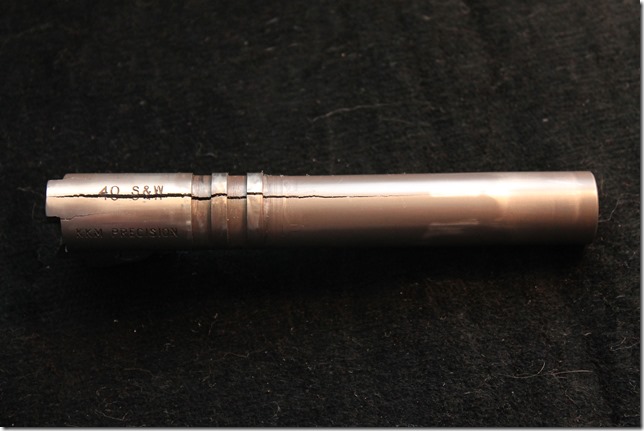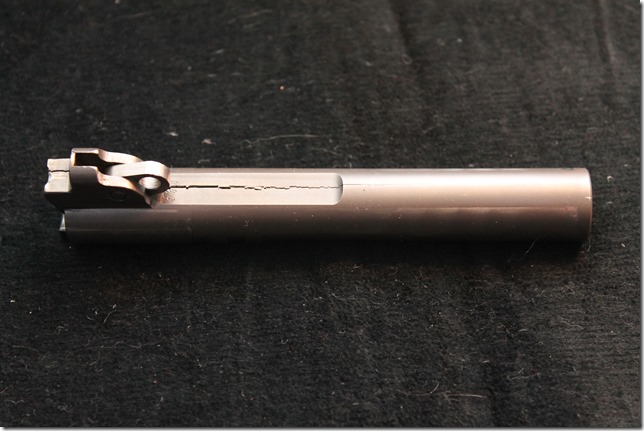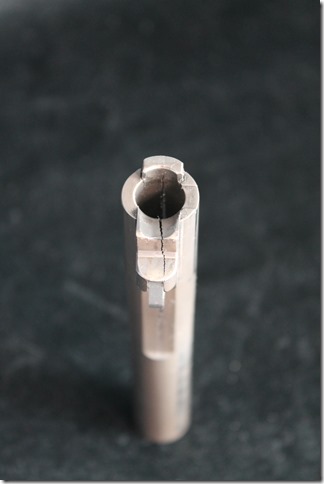As I reported last month the barrel in my STI Eagle attempted to spontaneously disassemble. I couldn’t get the slide open and figured I would just put the gun on the shelf that way. But Jacob said he was interested in doing a professional metallurgical evaluation of it. So I put some effort into extracting the barrel from the gun.
First I used a punch and drove the slide stop out far enough to get a finishing nail partially under it so that it was exposed:
Then brother Doug used an air powered cutoff tool to cut the slide stop almost in two and then pried the slide stop out:
The slide then easily came off. I then used a hammer (and other tools) to tap on the barrel to remove it from the slide.
The end result is that I was able to discover the barrel split about three fourths of its length:
As I looked at this barrel I remembered something. That flat spot on the bottom of the barrel was not there when it came from the factory. That was machined by an STI gunsmith so that a Recoil Master would fit. This would have weakened the barrel.





Cue comparisons of the FLGR to the Biblical “abomination that makes desolation” in 3, 2, 1….
http://booksbikesboomsticks.blogspot.com/2008/11/match-dissection-para-review.html?m=1
If you can post some dimensions I can try my hand at a FEM and see what nastran thinks of that flat spot.
That would be interesting.
From my non-expert point of view, I have a couple of comments. First, I’m shocked that STI would build an accessory allegedly designed for a 1911, that doesn’t even come close to fitting in the gun. Requiring major butchery on the barrel like that seems just utterly insane. A “gun smith” who does such a thing would not ever get my business.
Second, the crack pattern doesn’t look like it’s directly related to that change. If it were just on the flat, sure. But it’s both top and bottom. I wonder if it is a heat treatment error. I wouldn’t think that properly treated barrel steel would be brittle enough to crack like that.
Honestly it doesn’t look like the machining was the proximate cause of failure.
The biggest split was directly over the chamber, which is opposite a part of the barrel that was not machined and did not obviously split in the pictures posted. I think professional analysis will show stress fracturing along a seam that was put into the barrel during part of the forging portion of the manufacturing process.
What part of a barrel forging process involves creating of seams? That doesn’t fit what I understand of barrel forging, or making of barrels by any other process.
Joe, send that barrel off to Phil – he has newly-acquired Welding Skillz and could TIG that split right up for you! 🙂
You weren’t, per chance, shooting reloads were you? That barrel looks like a double charged case was fired in it.
I seriously doubt the machining caused it, given the top of the barrel appears to be split wider than the bottom.
I was using reloads but I don’t think that was a contributing factor. Look at the brass in my previous post on the event.
Hmmm, It’s a curiosity that the case didn’t swell, or the primer flatten, but the crack still looks like a double charge, or a normal charge fired into a squib already in the barrel. I’ve seen that look a couple of times at the range (not my gun, nor fired by me). Still, it’s just my opinion, and I mean no offense to you, Joe. I’m sad to see a nice gun get broken. -Rodger
There appear to be cracks around the rear of the hood where it meets the chamber. Definitely one on the right side that angles toward the front top of the chamber. Not sure about the left side. These may indicate an overpressure condition.
I find it interesting that the bottom crack propagated through the ramp mass.
Interesting. I should show this to my boss. I work in manufacturing QA, and this is the sort of thing we deal with.
I think AM may have it right. It sure doesn’t -look- like the machining was the cause. A metallurgical analysis might be in order.